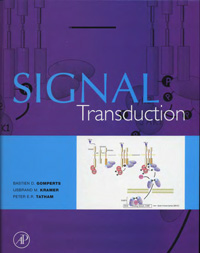Signal Transduction
| Автор(ы): | Gomperts D. Bastien
06.10.2007
|
| Год изд.: | 2002 |
| Описание: | Many people have asked for whom this book has been written and the most honest answer must be that it has been written for ourselves. It is our hope that it will also be both instructive and entertaining for students and professionals at many levels. We hope it avoids the worst excesses of the skimpily edited multi-author texts written by specialists, but necessarily this means that we have had to tread warily in areas in which none of us has first-hand experience, let alone expertise. Although we have touched the front edges of the subject, we have also endeavoured to provide an elementary basis with some historical background to all the topics covered. There has been no attempt to be comprehensive and we are aware that important topics that well qualify for inclusion in a book having the title Signal Transduction are conspicuous only by their absence. An obvious example must be the signalling processes that guide early embryonic development. Another is the field of signal transduction in plants. |
| Оглавление: |
 Обложка книги.
Обложка книги.
Transduction, the word and its meaning: one dictionary, different points of view [1] Hormones, evolution and history [2] Hormones: a definition [9] Neuro transmitters [10] Ergot [12] Receptors and ligands [14] 2 First messengers [19] Hormones [19] Binding of ligands to receptors [25] 3 Receptors [33] Adrenaline (again) [33] (?)- and (?)-adrenergic receptors [34] Acetylcholine receptors [38] Ion channel-linked receptors [42] The 7TM superfamily of G-protein linked receptors [51] Receptor-ligand interaction and receptor activation [58] Transmitting signals into cells [62] Intracellular 7TM receptor domains and signal transmission [65] Adrenaline (yet again) [66] 4 GTP-binding proteins and signal transduction [71] Nucleotides as metabolic regulators [71] GTP-binding proteins, G-proteins or GTPases [72] Ras proteins [85] Ras-GAPs [92] Essay: Activation of G-proteins without subunit dissociation [95] 5 Effector enzymes coupled to GTP-binding proteins: Adenylyl cyclase and phospholipase С [107] Adenylyl cyclase [107] Phospholipase С [119] 6 The regulation of visual transduction [127] Sensitivity of photoreceptors [127] Photoreceptor mechanisms [130] Adaptation: calcium acts as a negative regulator [135] Photo-excitation of rhodopsin [137] Switching off the mechanism [139] A note on phototransduction in invertebrates [141] 7 Calcium and signal transduction [145] A new second messenger is discovered [145] Calcium and evolution [146] Distinguishing Ca(?) and Mg(?) [147] Free, bound and trapped Ca(?) [148] Cytosol Ca(?) is kept low [149] Detecting changes in cytosol Ca(?) [150] Mechanisms that elevate cytosol Ca(?) concentration [153] The pattern of cytosol Ca(?0 changes in single cells [162] Localization of intracellular second messengers [166] 8 Calcium signalling [171] Calcium binding by proteins [171] Effects of elevated calcium [172] Paradigms of calcium signalling [181] 9 Phosphorylation and dephosphorylation: Protein kinases A and С [189] Protein phosphorylation as a switch in cellular functioning [189] cAMP and the amplification of signals [191] Protein kinase A [192] Protein kinase A and the regulation of transcription [194] Protein kinase A and the activation of ERK [196] Actions of cAMP not mediated by PKA [197] Protein kinase С [198] The protein kinase С family [199] Structural domains and activation of protein kinase С [201] Multiple sources of DAG and other lipids to activate PKC [204] Differential localization of PKC isoforms [205] PKC anchoring proteins, STICKS, PICKs and RACKs [205] PKC and cell transformation [208] PKC and inflammation [212] 10 Growth factors: Setting the framework [225] Viruses and tumours [225] The discovery of NGF ... and EGF [227] Platelet derived growth factor [230] Transforming growth factors [231] Problems with nomenclature [232] Essay: The cell cycle [232] Essay: Cancer and cell transformation [246] 11 Signalling pathways operated by receptor protein tyrosine kinases [257] The tyrosine kinase family [257] Tyrosine kinase-containing receptors [259] Branching of the signalling pathway [265] A switch in receptor signalling: Activation of ERK by 7TM receptors [276] 12 Signalling pathways operated by non-receptor protein tyrosine kinases [283] The non-receptor protein tyrosine kinase family [283] Interferons and their effects [290] Oncogenes, malignancy and signal transduction [292] Essay: Non-receptor protein tyrosine kinases and their activation [294] 13 Phosphoinositide 3-kinases, protein kinase В and signalling through the insulin receptor [299] Insulin receptor signalling; it took some time to discover [299] PI 3-kinase [300] Insulin: The role of IRS, PI 3-kinase and PKB in the regulation of glycogen synthesis [306] Other processes mediated by the 3-phosphorylated inositol phospholipids [309] Multiple kinases and multiple phosphorylation sites, PDK1 as an integrator of multiple inputs [310] So, who did discover insulin? [310] 14 Signal transduction to and from adhesion molecules [315] Adhesion molecules [315] Adhesion molecules and cell survival [325] Adhesion molecules and regulation of the cell cycle [328] Adhesion molecules as tumour suppressors [331] Essay: Apoptosis [335] 15 Adhesion molecules and trafficking of leukocytes [345] Inflammation and its mediators [345] TNF(?) and regulation of adhesion molecule expression in endothelial cells [349] 16 Signalling through receptor bound protein serine/threonine kinases [359] The TGF(?) family of growth factors [359] Downstream signalling; Drosophila, Caenorhabditis and Smad [364] 17 Protein dephosphorylation and protein phosphorylation [373] The importance of dephosphorylation [373] The role of PTPs in signal transduction [376] Negative regulation through dephosphorylation [378] Serine-threonine phosphatases [383] Classification of protein serine-threonine phosphatases [384] 18 Protein domains and signal transduction [393] Structurally conserved protein modules [393] Domains that bind oligopeptide motifs [395] Domains that bind proteins and lipids [398] Polypeptide modules that bind Ca(?) [401] Protein kinase domains [403] Index [411] |
| Формат: | djvu |
| Размер: | 10094966 байт |
| Язык: | ENG |
| Рейтинг: |
274
|
| Открыть: | Ссылка (RU) |